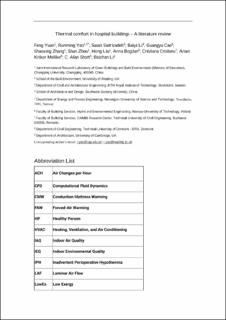| dc.contributor.author | Yuan, Feng | |
| dc.contributor.author | Yao, Runming | |
| dc.contributor.author | Sadrizadeh, Sasan | |
| dc.contributor.author | Li, Baiyi | |
| dc.contributor.author | Cao, Guangyu | |
| dc.contributor.author | Zhang, Shaoxing | |
| dc.contributor.author | Zhou, Shan | |
| dc.contributor.author | Liu, Hong | |
| dc.contributor.author | Bogdan, Anna | |
| dc.contributor.author | Croitoru, Cristiana | |
| dc.contributor.author | Melikov, Arsen Krikov | |
| dc.contributor.author | Short, Alan | |
| dc.contributor.author | Li, Baizhan | |
| dc.date.accessioned | 2022-03-07T13:34:51Z | |
| dc.date.available | 2022-03-07T13:34:51Z | |
| dc.date.created | 2021-12-22T14:50:24Z | |
| dc.date.issued | 2022 | |
| dc.identifier.issn | 2352-7102 | |
| dc.identifier.uri | https://hdl.handle.net/11250/2983470 | |
| dc.description.abstract | Hospital buildings are required to secure a variety of indoor environments according to the diverse requirements of patients and staff. Among these requirements, thermal comfort is an important design criterion for indoor environmental quality that affects patients' healing processes and the wellbeing of medical staff. The patients’ thermal comfort is given priority due to their medical conditions and impaired immune systems. Thermal comfort and related contexts have been well-covered in many research articles; however, the number of review articles is limited. This article aims to conduct a holistic and critical review of existing studies offering insights on future research trends (180 articles were analyzed). The key research themes are identified using scientometric analysis. Focus is on influencing factors, field-surveys, improving measures and energy saving related to thermal comfort. The primary outcome concludes that ventilation systems play a key role in maintaining acceptable, thermally-comfortable conditions for patients and medical staff. It is also found that acceptable thermal comfort is highly case-dependent and varies substantially based on the health condition of the patient as well as the type and level of staff activities. The measures currently mentioned to minimize energy consumption are also discussed. Some interesting issues, including the inaccuracy arising from the use of predicted mean vote (PMV) and the impact of gender, age, and related factors on thermal comfort, have been noted. This review provides insights into the design and assessment of hospital thermal environments. | en_US |
| dc.language.iso | eng | en_US |
| dc.publisher | Elsevier | en_US |
| dc.rights | Attribution-NonCommercial-NoDerivatives 4.0 Internasjonal | * |
| dc.rights.uri | http://creativecommons.org/licenses/by-nc-nd/4.0/deed.no | * |
| dc.title | Thermal comfort in hospital buildings – A literature review | en_US |
| dc.type | Peer reviewed | en_US |
| dc.type | Journal article | en_US |
| dc.description.version | acceptedVersion | en_US |
| dc.rights.holder | This is the authors' accepted manuscript to an article published by Elsevier. Locked until 16.10.2023 due to copyright restrictions. | en_US |
| dc.source.volume | 45 | en_US |
| dc.source.journal | Journal of Building Engineering | en_US |
| dc.identifier.doi | 10.1016/j.jobe.2021.103463 | |
| dc.identifier.cristin | 1971538 | |
| cristin.ispublished | true | |
| cristin.fulltext | preprint | |
| cristin.qualitycode | 1 | |

